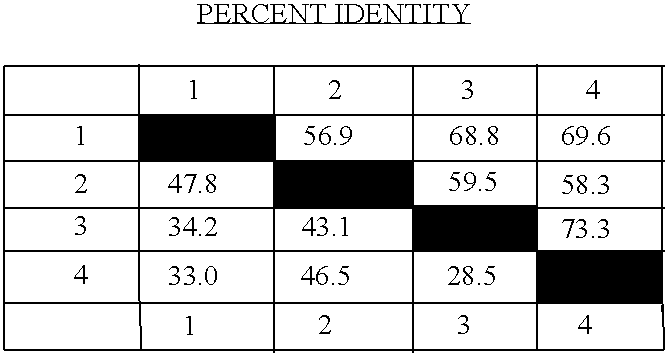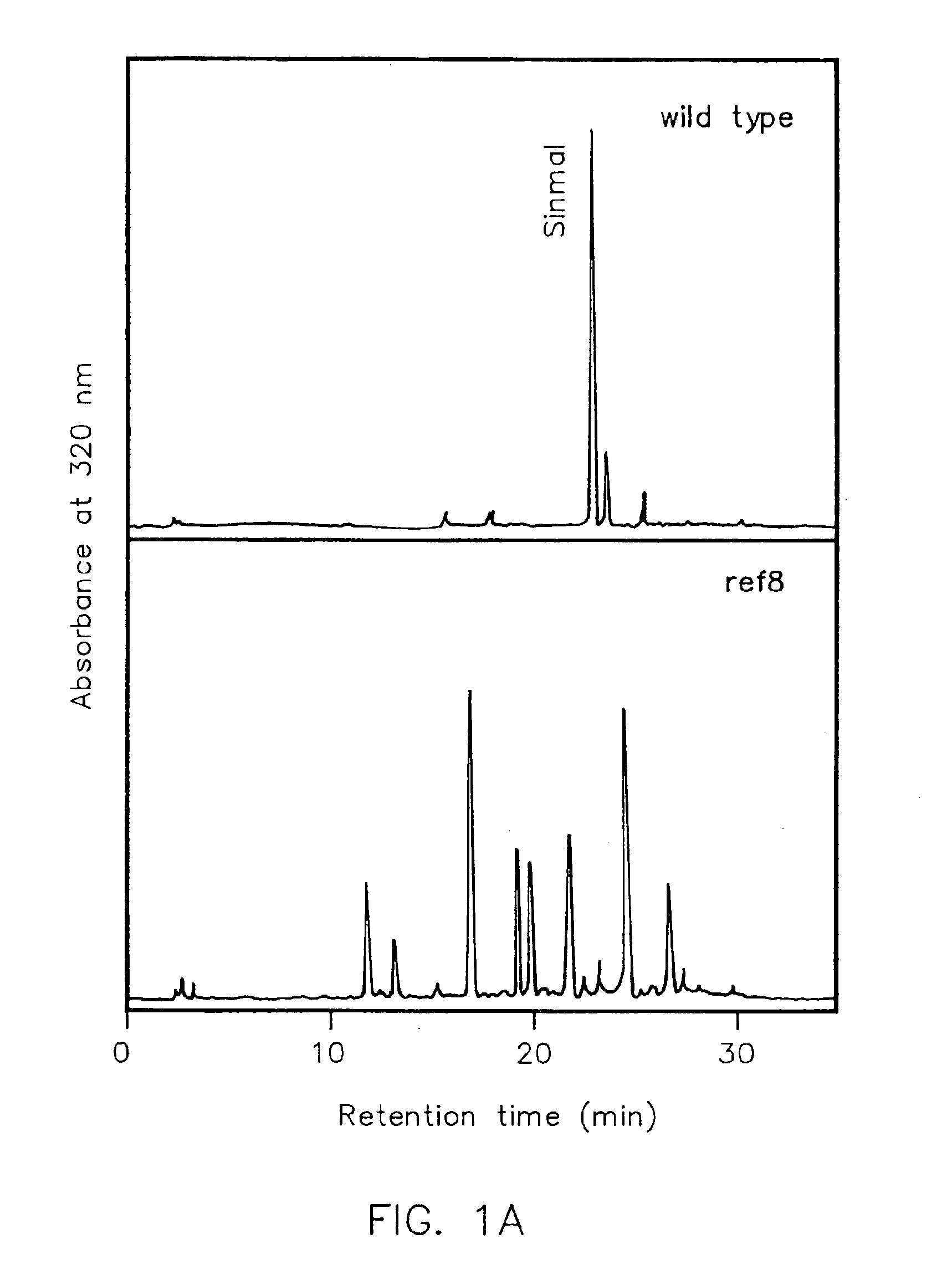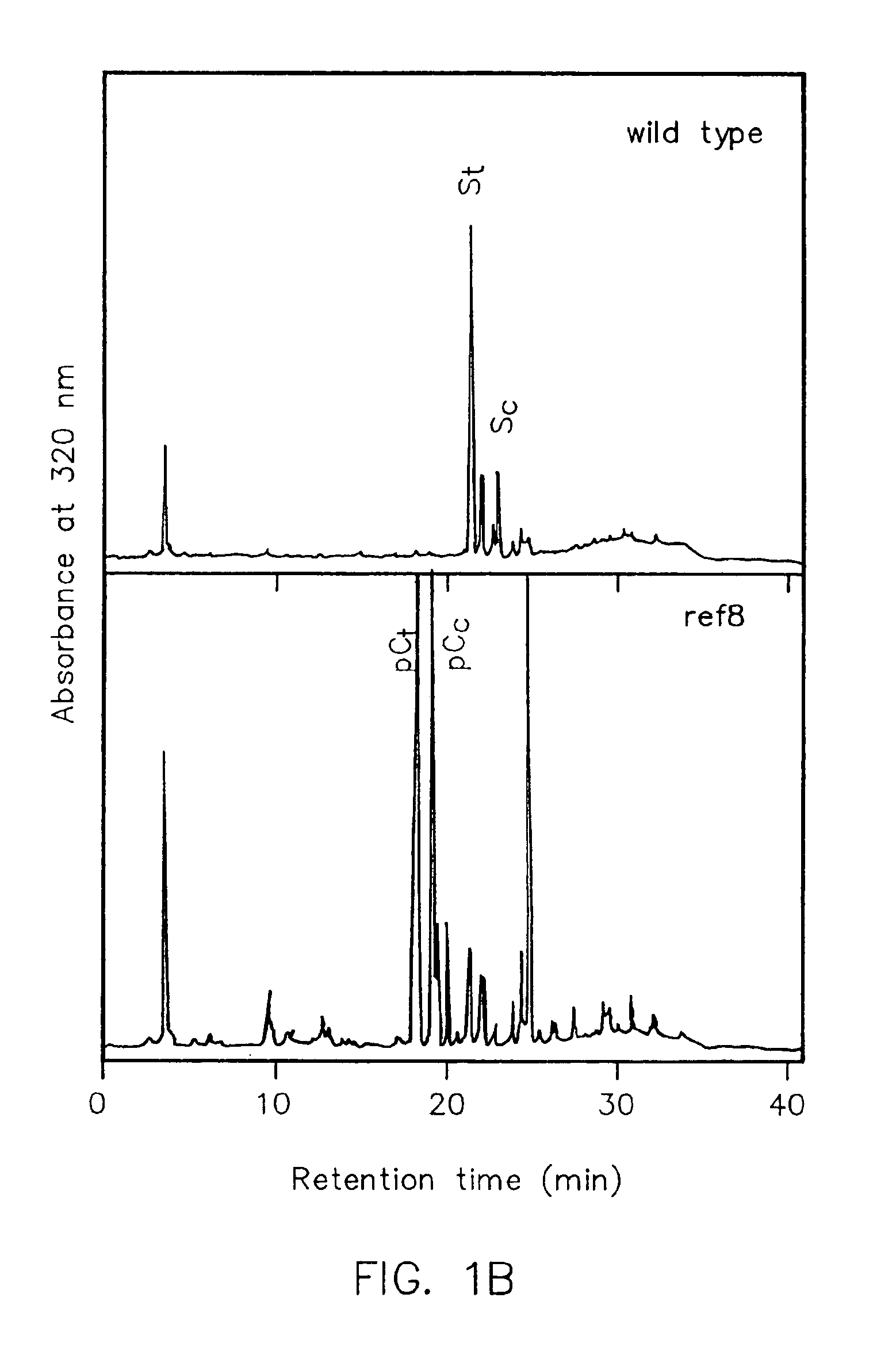Genes encoding p-coumarate 3-hydroxylase (C3H) and methods of use
- Summary
- Abstract
- Description
- Claims
- Application Information
AI Technical Summary
Benefits of technology
Problems solved by technology
Method used
Image
Examples
example 1
Evaluation of Phenylpropanoid Metabolism in ref8 Mutant
[0180]To identify mutants defective in sinapoylmalate biosynthesis, approximately 100,000 M2 seedlings (Columbia ecotype) were screened for individuals that exhibited altered cotyledon and / or leaf fluorescence when exposed to UV light. This mutant screen identified representatives of two known mutations that are affected in sinapate ester biosynthesis, fahl and sngl, as well as a number of additional mutant lines that define several other loci. Five of these have been phenotypically characterized (Ruegger and Chapple, in press), whereas the others have not, largely due to issues associated with vigor and fertility of the M2 plants and their progeny. The ref8 mutant was one belonging to this latter group.
[0181]When observed under UV light, the ref8 mutant is strongly red fluorescent, consistent with the absence of sinapoylmalate, and the accentuation of chlorophyll fluorescence that accompanies the lack of this UV-absorbing secon...
example 2
Evaluation of Cell-Wall Bound Polysaccharides from ref8 Mutant
[0190]Plant cell walls frequently contain hydroxycinnamic acids that are esterified to cell wall polysaccharides. To evaluate whether the ref8 mutation has an impact on cell wall-bound phenylpropanoids, wild-type and ref8 rachis cell wall preparations were subjected to alkaline hydrolysis to release esterified phenolics. HPLC analysis of cell wall hydrolysates with UV detection at 320 nm revealed that wild-type plants deposit ester-bound forms of p-coumaric and ferulic acid in their cell walls (FIG. 4). These extracts also contained substantial amounts of substances that co-chromatograph with vanillin and syringaldehyde, presumably arising from guaiacyl and syringyl lignin subunits, respectively. Although the cis-isomer of p-coumaric acid co-chromatographs with syringaldehyde in this system, similar experiments conducted on fahl cell walls which lack syringyl lignin and thus do not generate syringaldehyde revealed that on...
example 3
The ref8 Mutation Affects Lignin Biosynthesis Qualitatively
[0192]We have previously found that some Arabidopsis mutants defective in sinapate ester metabolism also exhibit alterations in lignin biosynthesis. To examine the impact of the ref8 mutation on lignin content, we analyzed cell wall material using thioglycolic acid (TGA) derivatization (Campbell and Ellis, 1992), and the Klason method (Kaar et al., 1991) (Table 3). These analyses indicated that the lignin content of ref8 stems was reduced to 20 to 40% of wild-type levels, depending upon the method employed.
[0193]From the decrease in lignin content seen in the ref8 mutant, it can be expected that down-regulation of C3H polypeptide activity in other plants would lead to similar decreases in lignin deposition. Considering that lignin content has is an important determinant in the use of lignocellulosic plant materials for purposes such as pulp and paper production, and influences the nutritional quality of forages fed to animal...
PUM
| Property | Measurement | Unit |
|---|---|---|
| Fraction | aaaaa | aaaaa |
| Fraction | aaaaa | aaaaa |
Abstract
Description
Claims
Application Information
 Login to View More
Login to View More - R&D
- Intellectual Property
- Life Sciences
- Materials
- Tech Scout
- Unparalleled Data Quality
- Higher Quality Content
- 60% Fewer Hallucinations
Browse by: Latest US Patents, China's latest patents, Technical Efficacy Thesaurus, Application Domain, Technology Topic, Popular Technical Reports.
© 2025 PatSnap. All rights reserved.Legal|Privacy policy|Modern Slavery Act Transparency Statement|Sitemap|About US| Contact US: help@patsnap.com



